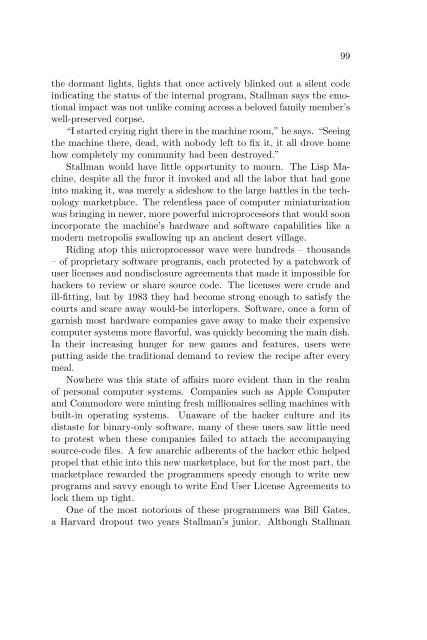Create successful ePaper yourself
Turn your PDF publications into a flip-book with our unique Google optimized e-Paper software.
the dormant lights, lights that once actively blinked out a silent code<br />
indicating the status of the internal program, Stallman says the emotional<br />
impact was not unlike coming across a beloved family member’s<br />
well-preserved corpse.<br />
“I started crying right there in the machine room,” he says. “Seeing<br />
the machine there, dead, with nobody left to fix it, it all drove home<br />
how completely my community had been destroyed.”<br />
Stallman would have little opportunity to mourn. The Lisp Machine,<br />
despite all the furor it invoked and all the labor that had gone<br />
into making it, was merely a sideshow to the large battles in the technology<br />
marketplace. The relentless pace of computer miniaturization<br />
was bringing in newer, more powerful microprocessors that would soon<br />
incorporate the machine’s hardware and software capabilities like a<br />
modern metropolis swallowing up an ancient desert village.<br />
Riding atop this microprocessor wave were hundreds – thousands<br />
– of proprietary software programs, each protected by a patchwork of<br />
user licenses and nondisclosure agreements that made it impossible for<br />
hackers to review or share source code. The licenses were crude and<br />
ill-fitting, but by 1983 they had become strong enough to satisfy the<br />
courts and scare away would-be interlopers. Software, once a form of<br />
garnish most hardware companies gave away to make their expensive<br />
computer systems more flavorful, was quickly becoming the main dish.<br />
In their increasing hunger for new games and features, users were<br />
putting aside the traditional demand to review the recipe after every<br />
meal.<br />
Nowhere was this state of affairs more evident than in the realm<br />
of personal computer systems. Companies such as Apple Computer<br />
and Commodore were minting fresh millionaires selling machines with<br />
built-in operating systems. Unaware of the hacker culture and its<br />
distaste for binary-only software, many of these users saw little need<br />
to protest when these companies failed to attach the accompanying<br />
source-code files. A few anarchic adherents of the hacker ethic helped<br />
propel that ethic into this new marketplace, but for the most part, the<br />
marketplace rewarded the programmers speedy enough to write new<br />
programs and savvy enough to write End User License Agreements to<br />
lock them up tight.<br />
One of the most notorious of these programmers was Bill Gates,<br />
a Harvard dropout two years Stallman’s junior. Although Stallman<br />
99


